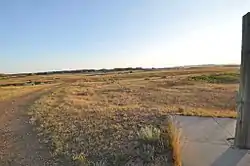Custer Military Trail Historic Archaeological District
The Custer Military Trail Historic Archeological District is a national historic district consisting of 18,149 acres (7,345 ha) located in Billings and Golden Valley Counties in North Dakota. The district includes five historic sites associated with the Plains Indian War from 1864 to 1876. The historic sites include Initial Rock, a site where George Custer's 7th Cavalry Regiment camped on May 28, 1876, en route to Little Bighorn. Two privates in Custer's regiment, W. C. Williams and F. Neely, carved their initials into a sandstone boulder at the site. The district also includes two additional military campsites, the site of the Battle of the Badlands, and portions of a military supply trail. The district was listed on the National Register of Historic Places in 2009. The district has five contributing sites.[1][2][3][4]
Custer Military Trail Historic Archeological District | |
 Easy Hill Camp | |
| Nearest city | Medora, North Dakota |
|---|---|
| Area | 18,149 acres (7,345 ha) |
| Built | 1864 |
| NRHP reference No. | 08001293[1] |
| Added to NRHP | June 5, 2009 |
References
| Wikimedia Commons has media related to Custer Military Trail. |
- "National Register Information System". National Register of Historic Places. National Park Service. July 9, 2010.
- "Press Release - ND Archaeological Trail Listed in National Register". State Historical Society of North Dakota. July 2, 2009. Archived from the original on July 9, 2009.
- "ND Archaeological Trail Nabs Historic Honor". KFYRTV. 2009. Archived from the original on 2013-01-27.
- "Dakota Prairie Grasslands" (PDF). U.S. Forest Service. Retrieved August 1, 2012.